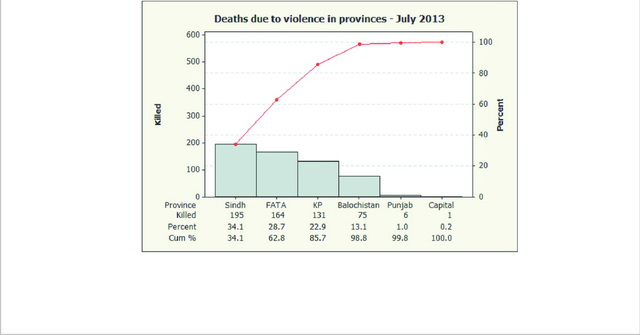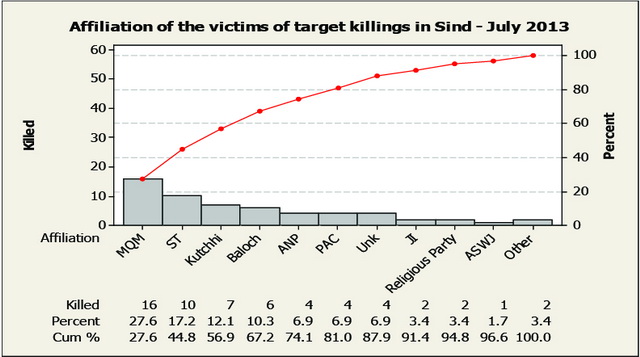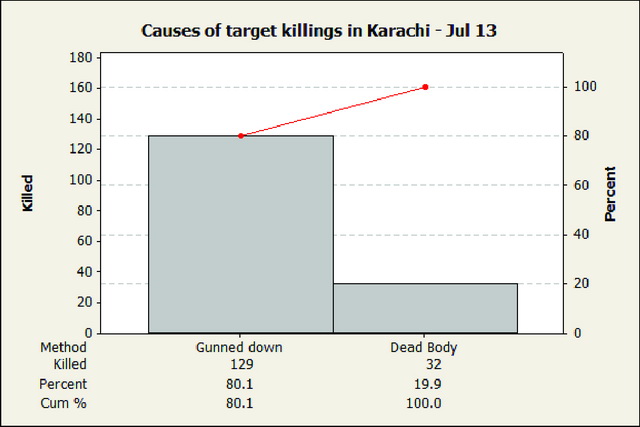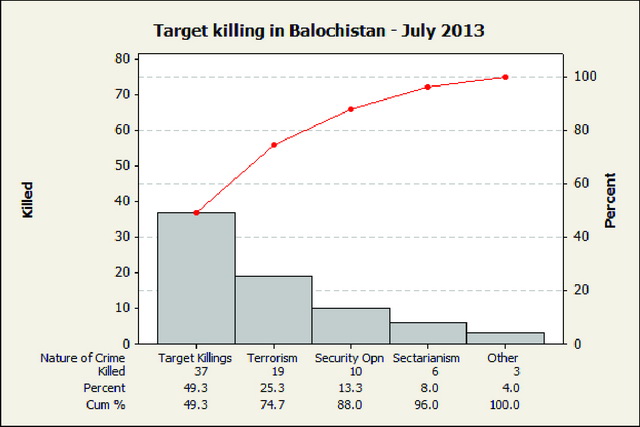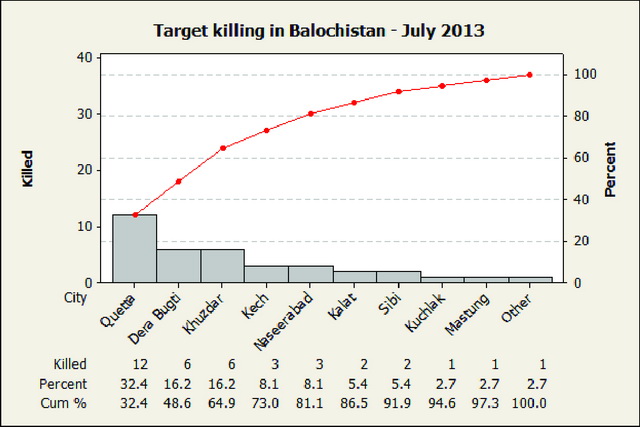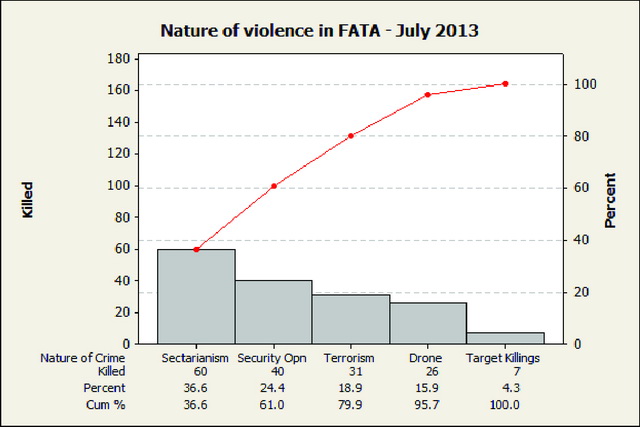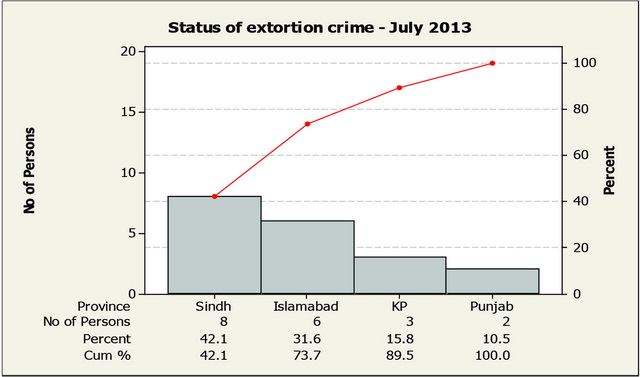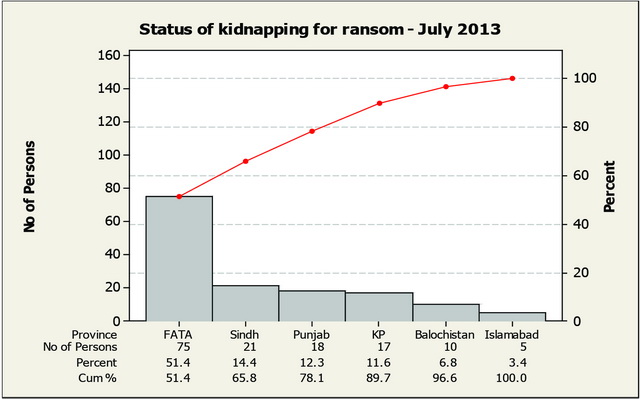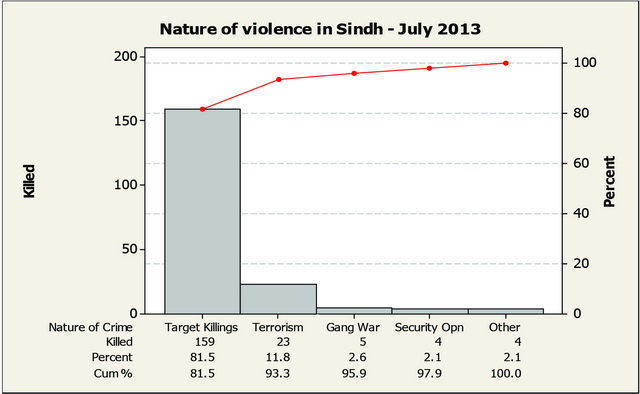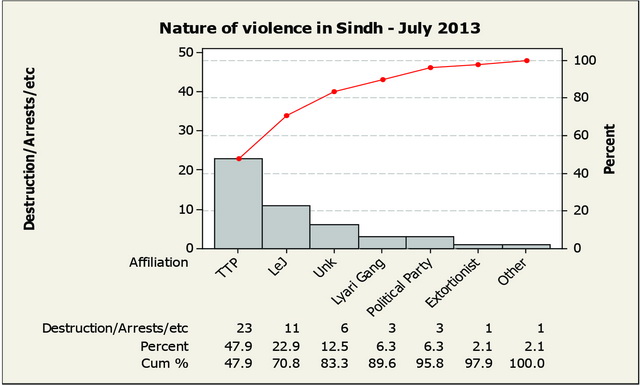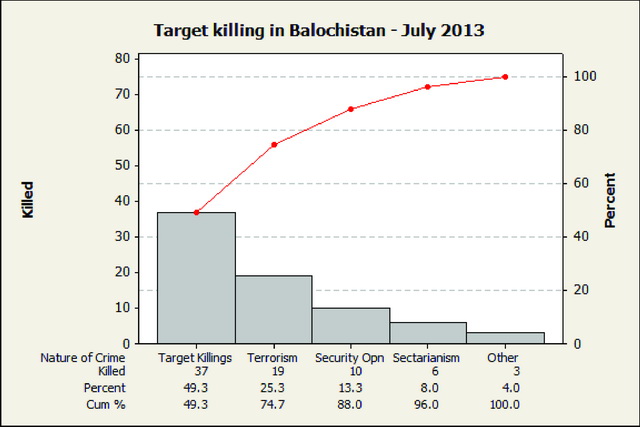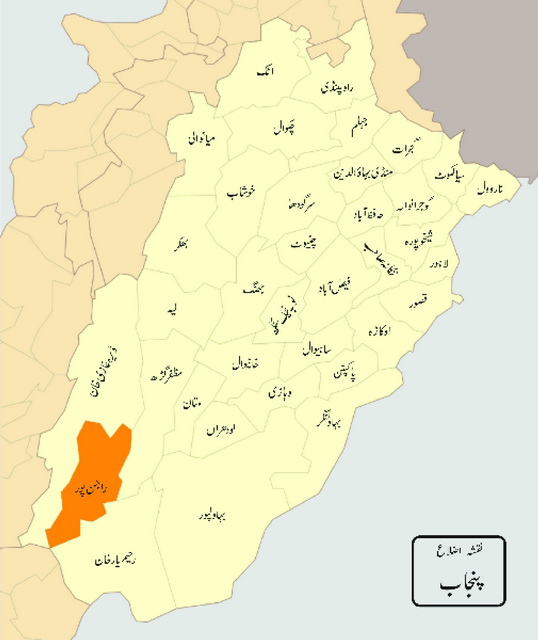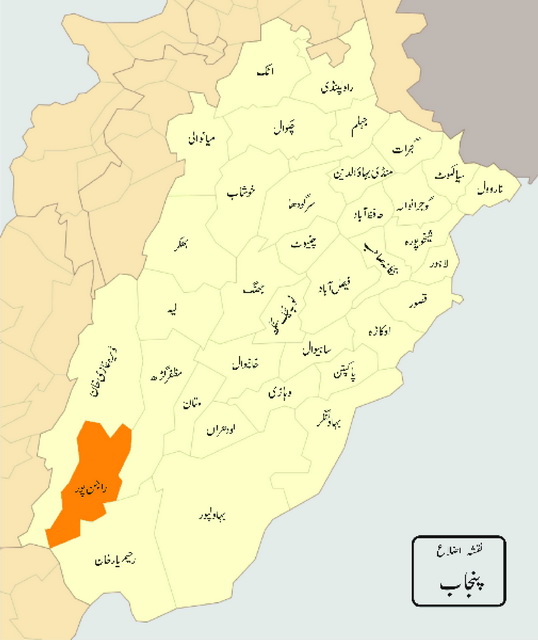Amidst the unending reports of killings, destruction, and miseries one good news for this month was of Malala Yousufzai address at the UN Assembly on 11 July 2013 wherein the young girl from the militancy-hit Swat urged the world community to ‘take up “the weapon of knowledge” in their campaign for access to education for all children around the world.’ It was the day when Pakistan appeared on the world screen with a face that is quite contrary to the dreaded images of bearded and truboned religious radical militants who are on a killing-spree across Pakistan. Ms Yousafzai appearance at the UN raised new hopes and aroused global sympathies for tens of thousands of Pakistani children, particularly those whose schools were blown up by militants claiming to be the true followers of Islam. But these moments of pride and happiness flowing from Malala address to the United Nations were shortlived; , Taliban responded in the same belligerent way and reiterated their resolve to target Malala Yousufzai ever returned to Pakistan[1]. No voice of protest or condemnation came from any corner and the writ of extremism remained supreme in the country.
During the month of July, there was no let up in violent extremism, intolerance and lawlessness. The casualties of violence during July also remained as high as 1214 (deaths 572 and injuries 642). Some new trends in military operations and drone attacks also surfaced. Also, an inconspicuous nexus among different banned outfits also emerged as a sign of new realignments for hitting the state and its interests.
Sporadic cases of people resistance to violence and terrorism were also reported from some areas, though a large number of Peace Lashkar members in tribal areas lost their lives to what we could presume target killings. In some cases complicity of some rogue elements in the law enforcement forces ´ inside informants ´ was also discernible, explained through several hostile exchanges between law enforcing agencies and militants/criminals, at times resulting in shameful retreats by state forces such as the daring jail break in Dera Ismail Khan, a southern district of Khyber Pakhtunkhwa, on July 30, raised serious questions about the preparedness of our security forces.
This report draws on information and news stories published in national newspapers. Errors and omissions, as always a possibility in all statistical works including this one, are expected. However, such mistakes do not grossly affect the basic objective of this report. This report mainly covers the following topics:
Target killings
Kidnapping for ransom and target killing
Terrorism and Security operation
Sectarianism
Drone attacks
CRSS will appreciate receiving comments that the readers may have on this report.
Report prepared by:
Mohammad Nafees
Senior Research Fellow
Center for Research and Security Studies
Data compilation by:
Fariha Farry
NOTE: Readers can approach CRSS for source of any information included in the report. Please send your request to: mail@crss.pk, nabila@crss.pk
OVERVIEW
Deaths due to violence in the country during July 2013:
Most of the indicators of violence in the country remained unchanged during the month of July. Sindh, FATA, KPK, and Balochistan were as highly affected by violence during this month as they were earlier (Refer to Graph 1). Unusual violent incidents took place also in Punjab, which has thus been largely peaceful. It suffered an act of terrorism as well as a humiliating and shameful release of abducted policemen in exchange for criminals. Target killing, terrorism, and sectarianism continued taking the highest number of tolls during this month as well (Refer to Graph 2) and, like always, the highest victims were civilians, militants, government officials (soldiers, frontier constabulary, levies, and police), politicians (activists and supporters) and members of pro-government peace lashkars (Refer to Graph 3). Among all big cities and districts of the country, Karachi suffered the highest number of deaths followed by tribal areas of Kurram and Khyber agencies (Refer to Graph 4). Although militants are relentless in their terror campaign, yet, some reports suggest that some people do take steps to resist these onslaughts of the terrorists. All acts of terrorism, counter terrorism, and resistance by the people resulted in deaths of 572 persons and injuries to about 640. This report along with the factual data would hopefully help the readers understand the broader picture of nature and trends of violence that has been sweeping the country for a long time.
Graph 1: Number of people killed in provinces due to violence:
Graph 2: Nature of violence in Pakistan ´ July 2013
Graph 3: Victims of violence in June 2013:
Graph 4: Number of persons killed in cities during July 2013:
Using the data and related press reports, this is an effort to take a look at the nature of crimes, their possible causes, and their growing trends in areas that are affected of them. It is an effort to break certain myths about different crimes and common misunderstanding about them. To do this, this report will take close look at all crimes in details.
Target killings:
Target killings accounted for most deaths during the month of July. Over 70% of the victims belonged to the province of Sindh, followed by Balochistan (16%), KPK (9%),and FATA (4%). In Sindh, with the exception of one incident of target killing in Sukkur, all victims were from Karachi. In other provinces, this menace appears to have infected most of their urban centres. (See Graph 5).
Graph 5: Target killings in cities:
Target killings in Sindh::
During July, Sindh lost 160 persons due to target killing and majority of them were civilians (98), political activists/supports (42), security officials (14), criminals (4), and two religious person. Only one of these victims was from Sukkur and the rest were from Karachi. Out of 47 political activists and supporters that were killed in the country during the month of July, 45 were from Sindh (42 due to target killings and 3 due to terrorism). MQM had the highest victims (16) followed by Sunni Tehreek (10) and others (See Graph 6). Among these political activists, there were a good number of people who belonged to Kutchhi and Baloch communities that were targeted because of the ongoing gang war between two groups allegedly having links with the mainstream political parties, PPP and MQM. This situation led several thousand Lyari residents to migrate temporarily to other locations in the region.
Graph 6: Affiliation of the victims of target killing in Karachi:
Karachi city is becoming a cobweb of all kinds of crimes. Besides political rivalry, sectarian killings, gang war, and the kidnapping for ransom the acts of terrorism have also become a new but highly fatal crime devouring a large number of people in the city. Karachi is no longer a play ground of a few political parties and land mafia. Like its multi-ethnic population the acts of crime have also become multi-dimensional encompassing political, religious, ethnic, and militant organizations. Kidnapping and dumbping of the dead bodies is considered to be a serious and very common crime in Balochistan. When we look at the data we find that Karachi is more affected of this crime than any other place in the country. In July, there were 32 dead bodies found in the city which is the half of the total number of dead bodies found through out the country (See graph 7).
Graph 7: Methods of target killings in Karachi ´ July 2013
Banned organizations like Tehreek-e-Taliban (TTP), Lashkar-e-Jhangvi (LeJ) and Lashkar-e-Islami (LI) have also become active in Karachi and other areas of Sindh. Terrorism and Security Operation chapter of this report will discuss their activities in detail.
The complex nature of crimes in Karachi, the largest populated commercial city of the country, can be assessed from these statements of security officials:
‘Talking to Dawn, the Sindh police chief agreed to the statement that the situation was getting from bad to worse, saying that ‘policing in Karachi means facing several threats simultaneously’[2].
‘Apart from conventional crimes, the police are now handling the terrorism threat as well,’ said Ahmed Chinoy, the chief of the Citizen Police-Liaison Committee[3].’
Target Killing in Balochistan:
Like Sindh, target killing was the major contributor of deaths in Balochistan during the month of July followed by terrorism, security operation, and sectarianism (See graph 8). However, unlike Sindh, target killing was not confined to one district of Balochistan only; it was rather spread throughout the province with Quetta, Dera Bugti, and Khuzdar as the highest affected districts of the province (See graph 9).
Graph 8: Causes of deaths in Balochistan ´ July 2013
Graph 9: Deaths due to target killing in Balochistan ´ July 2013
The total number of dead bodies found in Balochistan during the month under review was eight, out of which 6 were found in Dera Bugti and 2 in Quetta. It another crime that not confined to one district of the province only as is the case in Sindh where all dead bodies were found in Karachi. Prominent among the victims of target killings in Balochistan were:
Labourers – 3 in Naseerabad
Pro-government tribal lashkars – 3 in Dera Bugti ,
Professor – 1 Khuzdar Degree College
ATF personnel – 2 Anti-Terrorist Force (ATF) in Khuzdar and Qila Abdullah
Religious scholar & brother – 2 in Quetta
Politicians – 1 Mir Abdul Qadir Zarakzai of PMLN was injured and his
Driver was succumbed to his injury in Khuzdar
– 1 Noor Ahmed Buledi, cousin of National Party MPA
– 1 Ali Ahmed brother of Sardar Aziz Bizenjo of (BNP-A)
Hindu community – 1 person, Kishwar Kumar, was killed in Quetta
Terrorism, insurgency, and sectarianism are the major causes of the target killings and the identity of the victims of this crime does carry foot prints of these causes.
Target killings in KPK and FATA:
In KPK, target killing is not the major cause of deaths. 22 out of 133 deaths were because of target killing during July (See graph 10). Some of the key persons that were targetted reflect the causes behind those acts:
Graph 10: Deaths due to nature of violence in KPK ´ July 2013
List of the key persons targeted in KPK:
Anti-polio workers:
1 Swabi
2 Lady health worker and her daughter in Tank
Pro-government Peace Lashkar:
2 in Tank
1 in Mingora
1 in Swat
2 in FR Peshawar
Government officials:
1 Former assistant director of Intelligence Bureau, Mujahid Khan, in Peshawar
1 Muhammad Arif, a former DG of the IB in Peshawar
1 Deputy Commandant of Frontier Reserve Police (FRP) Gul Wali Khan, in Peshawar
5 Policemen on different dates in Peshawar
2 Deputy Commandant of Frontier Reserve Police (FRP) Gul Wali Khan and his driver in Peshawar
In FATA too, target killing is not a very common cause of death and it is mostly a part of the local insurgent movement led by different militant groups. During July, there were seven deaths due to target killing at the following locations:
2 Tribesmen killed, three injured in firing on a passenger bus in Bara
3 Tribal elder Jamshed Khan Khojalkhel along with his younger brother Minhaj Khojalkhel and friend in Wana
1 An activist of a banned outfit was killed by a volunteer of a local peace committee in Bara
1 A peace committee member was killed and six injured in exchange of fire in Tirah valley
From the list of these victims, it is clear that, unlike Karachi, the target killing in KPK and FATA is not multi-dimensional in its character and the most dominant cause of it is the ongoing insurgency in the tribal regions and KPK (See graph 11).
Graph 11: Deaths due to acts of violence in FATA ´ July 2013
Target killings in Capital, Pujab, and GB:
Except one case of a suspected target killing in the capital city of Islamabad, there were no reports of target killing from Punjab or GB. According to a press report, A businessman was burnt alive in his car with his hands tied behind by his opponents on Monday in a deserted place near ¿Niazian– falling in the jurisdiction of Sihala Police Station of Islamabad.
Kidnappings, extortions, and target killings:
Missing persons– issue has been of a great concern to most of social activists, judiciary, and religious political parties but what they almost miss amidst this serious concern of theirs are the ever-increasing cases of kidnappings for ransom and extortions that play havoc to the victims and often turn out to be one of the major factors for target killings in the country. No province of the country is safe from this crime and according to the former Deputy Inspector General Police Operations of Balochistan, Hamid Shakeel, 78 gangs involved in kidnapping for ransom operate in Quetta city alone[4]. However, the nationalist parties and the parliamentarians in Balochistan raise their voice most of the time on missing persons that, in their opinion, are kidnapped, killed, and dumped by the security agencies. Asim Kurd, PMLN MPA from Balochistan said, ‘It has become a trend in our area that people get picked up, dumped and killed. Our security agencies blame banned outfits for these acts, which is untrue and gives a wrong message.[5]‘ Hearing the missing persons case, the Peshawar High Court (PHC) on 5 July 2013 warned the intelligence agencies– personnel not to consider themselves above the law and ruled that the personnel of the spy agencies working in Khyber Pakhtunkhwa and Federally Administered Tribal Areas (Fata) would be booked for kidnappings and illegal detentions of citizens if any missing person was found in their custody or transferred to the internment centers[6].
During a hearing of a kidnapping case in the Peshawar High Court, the Deputy Attorney General Muhammad Iqbal Mohmand revealed that the foreign agencies including Research and Analysis Wing (Raw) of India and Mossad of Israel and others are involved in such activities[7].
One of the well-known lawyers in Islamabad, Mr Babar Sattar, made a startling revelation in his column that said, ‘…on average there are around one thousand kidnapped citizens held for ransom in North Waziristan at any given time. The story of extortion is even more alarming.(CRSS Note: The figure seems quite exaggerated, yet this does not belittle the kidnapping-for-ransom industry that is thriving both in the northwestern and southwestern territories (Balochistan) All kinds of extortion rackets ´ some franchised by the TTP and others just making hay while they can ´ are collecting money from anyone who has the ability to pay[8].’ Adenzai Qaumi Jirga in Chakdara, Lower Dir also expressed its concern over the growing incidents of kidnapping in the area while a press report on 23 July 2013 brought to light a newly-established ‘parchi (threat note)’ system that is being used for extortion of money in FR Peshawar area that began forcing people to migrate to safer places[9].
Talk of the kidnappings for ransom and extortion of money usually go hand in hand. . Accompanying this is yet another, though not frequently practicsed phenomenon; kidnappings for exchange of criminals.
We will discuss all aspects of these crimes in details to have a better understanding of how fast this crime is spreading throughout the country and what serious dimensions it is assuming with every passing day. First, let take a look at the reported incidents of kidnappings during the month of July and see where the most kidnappings took place and who was more commonly reported to be involved in it. Based on the press reports, it appears that FATA is the place where most of the kidnappings took place during the last two months ´ June and July. However, the other provinces were not safe from it either (See graph 13).
The cases of extortion were mostly reported from Sindh and Islamabad and if we look at the amount of money demanded by the extortionists the victims of Islamabad and Rawalpindi were more affected based on the press reports. (See graph 12). In terms of numbers and the amount of money demanded Punjab (if taken together with federal capital Islamabad) tops kidnappings for ransom and extortion crimes. Other than some unknown or little known criminal gangs, there are some well known militant organizations reportedly engaged in this crime. According to the data we collected from the press, Lashkar-e-Islami (LI) had abducted 73 persons, Lashkar-e-Jhangvi (Chhotu Mazari Group) kidnapped 17 persons, and Taliban were involved in kidnapping of 12 persons during the month. All reports of kidnapping for ransoms are included in this study as an attachment ‘A’.
Graph 12: Status of extortion crime ´ July 2013
Graph 13: Kidnappings for ransom ´ July 2013
Kidnapping for exchange of criminals:
The cases of kidnappings reported from FATA, KPK, and Punjab were basically for extortion of money, political issues, and exchange of kidnapped persons with the comrades of the kidnappers. There were two prominent cases such kidnappings; one from FATA and the other from Punjab. On July 1, Lashkar-e-Islam (LI) in FATA set free 16 out of 60 jirga members that they abducted and detained on 6 June. These jirga members were sent Suhail Afridi, a candidate of Pakistan Muslim League-Nawaz (PML-N) for NA-46 to meet militants and lift ban on his campaign in Akakhel area. One of the jirga members was beheaded earlier on June 7. After killing one of the Jirga members and releasing 16 members this month, there are still 43 Jirga members in their custody. As a military operation has been going on in Khyber Agency to clear the area from LI and TTP hold and it might be one of the reasons that LI has not released all the detainees. The LI had also jailed six workers of Khidmat-e-Khalq Committee of Sepah tribe some two weeks back for carrying out election campaign for another candidate from NA-46 during the recent polls that they released after negotiation with the mediators on 30 June[10].
Another kidnapping case exemplifies all kidnapping categories the country is currently facing. It the kidnapping of eight workers of the water and power utility WAPDA from the under-construction Gomal Zam Dam in South Waziristan. Despite several attempts since the incident almost a year ago no resolution seems in sight. On 6 July, the kidnappers (in this case the Tehreek-e-Taliban of Pakistan) released another video of the kidnapped employees and threatened to kill one of them before releasing another video if their demands were not met by the government[11]. These workers were kidnapped on August 25, 2012 and, according to a press report of 25 January 2013, Taliban were demanding Rs.150 million as ransom and releasing of 17 hardcore militants for the safe return of the kidnapped employees[12].
The third case of kidnapping is from Rajanpur in Punjab that brought dishonorable submission of the Punjab police to hard core kidnappers and associates of the banned sectarian outfit Lashkar-e-Jhangvi.
On 7th July, armed gangsters belonging to a criminal group called Chhoto Mazari group attacked and injured three police constables and also took nine Police officials hostage. They were all deployed at two check posts on the riverside of the Indus in Rajanpur District. This incident of hostage-taking led to a series of unsuccessful efforts from Punjab police to get their colleagues rescued from Chhoto Mazari group. It took the police nearly 8 days of operation, engaging a force of 700 to 1200 policemen, and a number of negotiations with MPA Atif Mazari who struck the deal with Mazari aide Patt Umrani to secure the exchange. According to the information available on Defence of Pakistan website, ‘….the police on Tuesday released three Lashkar-i-Jhangvi (LJ) men in exchange for the release of eight policemen held hostage by Chotu Mazari, the same source revealed that Chotu gang had released three civilian abductees on receipt of Rs2 million ransom one of them was Dr Wazir Khan who was kidnapped three months ago[13].
These reports indicate how seriously the people are affected by the kidnapping for ransom and extortion crimes in the country and the data we collected from different newspapers during the month of July further confirms the severity of this problem (See attachment A).
Terrorism, security operations, and drone attacks:
Terrorism, security operations, and drone attacked continued on in the country causing deaths, destruction, and miseries to the people and all those who are involved in it. The concerning issue related with the terrorism is that during the month of July, it has not only become ferocious but more ubiquitous in the country. The thus far peaceful Punjab received a a jolt of terrorism when a bomb blast at the most popular shopping area, Anarkali, in Lahore killed 5 persons and injured nearly 38 persons on 7 July. However, the most of ideological, political, ethnic and sectarian terrorism remained concentrated KPK /FATA and Balochistan during the month of July (See graphs 12 and 13).
Terrorism in KPK and FATA:
The data on acts of terrorism and counter terrorism in KPK and FATA during the month of July show that the deaths due to terrorism were the highest in the regions (See graph 14).
Graph 14: Deaths due to acts of violence in FATA ´ July 2013
The month of July began with an attack of terrorists on a military convoy on Bannu-Miranshah road in North Waziristan killing four soldiers and injuring 16 of them[14]. On the same day, the militants fired some rockets at the populated area in Tyarza Khula in South Waziristan after which the tribesmen formed a ¿chagha– party and marched towards the location from where the rockets had been fired at their area. The militants fired at the marching tribesmen with heavy arms, leaving four tribesmen dead and 18 injured[15].
Only two days after these incidents, Taliban launched another serious attack on the Kishan Ganga check-post near Frontier Region (FR) of Peshawar, Jina Kor on 3 July. According to the daily Dawn, 250 militants had attacked the check-post[16] while The News reported the number of militants as 150[17]. The militants attacked the check-post at 11:00 pm and continued their onslaught against the security forces till the early hours of the morning. The militants destroyed at least four vehicles of the security forces and also bombed a building where the security check-post had been established. After killing six FC personnel and injuring 10 of them they were able to disappear without even leaving their companions who were died or injured during the conflict. An FC official Hizbullah claimed at least 6 to 8 militants were killed in the attack and many others were injured but the militants took away the bodies with them.
On the same day (July 3), a CIA-operated drone fired four missiles on a house near Miramshah bazaar in Sirai Darpakhel area, targeting the Haqqani residential compound and a car. The head commander Haji Shahrifullah of the HaqqaniNetwork, is said to be safe, whereas 17 people were killed and two others injured in the attack[18]. Those who killed in the strike included[19]:
– Mullah Akhtar Zadran, a ¿commander– of the Haqqani network,
– Abu Saif Al-Jazeri, an operative of Al Qaeda.
– Two Punjabi militant ¿commanders– ¶ Rana Ashraf and Naveed Butt.
– 13 victims were ¿foot soldiers–
Next day on 4th July, the security forces carried out an operation against the militants and killed two key militant commanders, Rooh ul Amin and Adnan alias Hurera, belonging to the outlawed Tehrik-i-Taliban Pakistan (TTP) in Peshawar[20]. On the same day, a suicide attack at a check-post in the North Waziristan left four security personnel dead and the check-post burnt down to ashes[21].
On 8th July, another suicide attack took place in Hangu when the bomber ran his motorcycle into a car at the bus stand in Doaba bazaar. As a result, nine persons were dead and 10 others were wounded including seven vehicles and several shops that were also destroyed in the blast[22]. On 9th July, a pro-government tribal elder, Malik Ghazi Marjan, and four others were killed in a remote controlled bomb attack in Hangu. Eleven passers-by were also injured[23].
On 13 July, a US drone fired two missiles at two people riding a motorcycle in Mossaki village in Mir Ali of North Waziristan. This was the second drone attack of the month[24].
On 15th July, security forces carried out air strikes in Darra Adamkhel bordering the Orakzai Agency and killed seventeen militants and injured 13. The official sources also claimed to have destroyed seven hideouts of the militants in the area[25]. The same day, a drone strike in the tribal regions killed nine suspected militants, including two foreigners[26].
On 19th July, ten militants and two soldiers were killed when the security forces carried out an operation against the Tehrik-e-Taliban in Zawa and Kharmatang area of Bara Tehsil in Khyber Agency[27]. In another operation on 21 July, Pakistan Air Force fighter jets pounded militant compounds and razed two hideouts to the ground and killed nearly 18 militants in Kharmatang area of FR Kohat[28].
Four days later, on 25 July, reports appeared in the press about the bullet-ridden dead bodies of 21 suspected militants in Khangai area of Bara division of Khyber Agency. The official explained that Khangai was a militant stronghold from where the militants use to infiltrate in FR Kohat, Peshawar and in Akka Khel and Orakzai Agency, operating from hideouts which the security operation bombed by gunships[29]. On the same day, five suicide bombers stormed the regional headquarters of the Inter-Services Intelligence (ISI) in Sukkur, killing at least two officials and injuring 35 others[30]. Tehreek-e-Taliban Pakistan (TTP) based in Mohmand tribal region and Punjab were reportedly involved in this attack. The attack, as reported later, resulted in deaths of three ISI officials ´ its assistant director Major Zeeshan, Naiks Abdul Aziz and Mohammad Asif including two other employees of ISI[31]. This attack reminds the brazen attack of LeJ linked Chhotu Mazari gang on check-posts in Rajanpur and abduction of 9 policemen on 7 July. Since Rajanpur district of Punjab is close to Sukkur district of Sindh, there is a possibility that the Chhotu Mazari gang might have provided support to the Taliban in this attack on ISI office.
On 28 July, a militant attack was launched on the Thall Frontier Constabulary (FC) check-post in Hangu at midnight during which two FC soldiers were killed and 20 others were injured. In retaliation to this attack, security forces claimed to have killed six to eight militants, one of them was supposedly an al-Qaeda linked Arab national[32].
The third US drone attack on 28 July killed seven people and injured three others in the Shawal area of North Waziristan[33].
On 30 July, the militants carried out two major attacks; one at Dera Ismail Khan Jail [34] and the other was on a border post in Darra Adamkhel[35]. Both attacks were carried out on Tuesday late night. According to reports, about 60 heavily armed militants attacked the checkpost in Sur Gar Range linking the Bara River-Patao Mela to Ublan Darra Adamkhel while in D.I. Khan Jail attack 150 militants were reported to be involved. The gun batter between the armed forces and militants at Darra Adamkhel was continued for more than two hours that left eight militants and two soldiers dead. In the D.I. Khan Jail break, the militants continued their operation uninterruptedly from 11:15pm on Monday till 2:30am on Tuesday. During this operation, they killed nine people and four policemen and rescued 250 jail inmates among whom there over 35 hard core militants. Taliban claimed the responsibility of this attack and confirmed that ‘Majority of our people along with the freed prisoners reached a secure place. Some of our very senior people also succeeded to escape,’ the spokesman claim
Terrorism in Sindh:
In Sindh, terrorism is the second major cause of killings after target killings. However, the number of victims is only 12% of the total number of victims of violence in the province (See graph 15). Unlike all other crimes in Sindh, terrorism, nevertheless, was not confined to Karachi city only. Sukkur, the other end of the province Sindh and close to the border area of the Punjab province, experienced an unprecedented act of terrorism on Julky 25 when militants launched a brazen attack on regional office of the ISI, the country prime intelligence outfit, killing three key agency officials and two staff members. Five suicide attackers were also killed during this incident. Tehreek-e-Taliban Pakistan (TTP) based in Mohmand tribal region and Punjab were reportedly involved in this attack.
Graph 15: Deaths due to acts of violence in Sindh ´ July 2013
For the last three months, the militant organizations have spread their operation to Sindh and a number of incidents carry their foot prints. Last month, for the first time, a High Court judge, Justice Maqbool Baqar was targeted in Karachi by a militant organization. Initially, the banned Tehreek-i-Taliban Pakistan (TTP) had claimed responsibility for the deadly attack saying that the judge had delivered ‘anti-Taliban and anti-Mujahideen judgements’. Justice Maqbool Baqar was on the hit list of TTP and LeJ for two reasons; his judgments and the Shia sect he belongs to. However, the police arrested Hafiz Bashir Laghari on 17 July 2013 as the suspect mastermind of bomb attack on Justice Baqar and the police official declared him as an associate of the banned Lashkar-e-Jhangvi (LeJ)[36]. Maulana Akbar Saeed Farooqi of the Ahle Sunnat Wal Jamaat (ASWJ) issued a press statement saying; ‘Hafiz Leghari has nothing to do with the Lashkar-i-Jhangvi or any other militant group as he also remained in touch with the local administration with religious scholars of all parties[37].’ Later, another report indicated that the suspect mastermind belonged to the ‘Asif chotu group’ of the Lashkar-i-Jhangvi, a banned militant outfit involved in several sectarian killings[38].
Although this ‘Asif Chotu group’ is not part of the infamous Chotu Mazari group of Rajanpur in Punjab, their association with the Lashkar-i-Jhangvi make them having one and the same background. There were two more incidents that had links with the Asif Chotu group in Karachi. On 21 July, KMC commissioner survived bomb attack near the Essa Nagri area on Sir Shah Suleman Road in the upscale Gulshan-e-Iqbal neighbourhood. As a result, the acting administrator, his police guard Sohail Anjum Siddiqui, driver Haroon and a passerby, Yamin, were wounded. The TTP spokesperson later claimed that the attack was carried out to target the metropolitan commissioner[39]. Half an hour later, a powerful blast tore through a house situated in the congested Patel Para neighjbourhood of Karachi[40]. The Express Tribune reported that the terrorists killed in the blast inside a house in Patel Para were experts in bomb making and had affiliation with the outlawed Lashkar-e-Jhangvi (LeJ) associated with the Asif Ramzi faction of the outlawed LeJ[41]. On 31 July, the Preedy police claimed to have arrested a notorious criminal and wanted terrorist, Qari Abdul Quddus of Lashkar-e-Jhangvi (LeJ) from the MA Jinnah road belonging to Naeem Bukhari and Asif Choto groups of LeJ[42].
The involvement of Asif Choto group in planning a attack on a mosque at Al Sabah Chowk in Gilgit was also reported on 26 July when the two teenagers belonging to this group were arrested by the police. According to the report, the youths were students of a madressah in Islamabad and brought to the LJ fold by one Salman, a resident of Peshawar. Salman took them to Miramshah for terrorism training[43].
Various Sind lost as many as 13 persons in suicide attacks, four in bomb blasts, two in hand grenade attack during the month of July. The police and rangers also reported to have arrested a number of criminals belonging to TTP, LeJ, Lyari Gang, and a political party (See graph 16).
Graph 16: Victims of the terrorism in Sindh ´ July 2013
According to a press report, the Counter Terrorism Unit (CTU) claimed to have arrested, Koochi Khan, from Keamari area who had reportedly confessed to have been working for the TTP Ameer, Noorullah, in Sohrab Goth and had carried out a number of target killing and extortioning in the city. On orders of Noorullah of TTP, he along with his gang of eight or nine members had killed ANP election candidate MPA Saddiq Zaman Khattak, his son Aimal Khattak, ASI Asalm Pervez of Karachi Traffic Police, Nadir Ali of Sindh Reserve Police, and police officer Jawed Iqbal. All of these victims were targetted in Korangi[44]. Another gangster, Akbar Maliri, belonging to another banned organization, People Amn Committee, was also reportedly arrested by Rangers from Malir. He was wanted in several cases of extortion, kidnappings and murder by different police stations of the city[45].
Terrorism in Balochistan:
During July, almost 25% deaths came off acts of terrorism. The highest casualties were recorded 28 July, when armed men attacked a security check-post in Gwadar, leaving behind 10 persons dead and 7 injured. The separatist Balochistan Liberation Front claimed to have carried out this attack[46]. Another incident of terrorism occurred at Chamman, a small town that borders Afghanistan on 11 July , when a suicide bomber exploded himself at the ¿Friendship Gate’ ´ the official border crossing – killing 7 persons and injuring 10[47].
Graph 17: Deaths due to acts of violence in Sindh ´ July 2013
Terrorism in Punjab:
After a long spell of peace and tranquility, Punjab experienced two high profile cases of terrorism during this month; one was in the provincial capital city of Lahore and the other was in Rajanpur district. On July 6,, an explosion at Anarkali Market, Lahore left five persons dead and 50 others wounded. Next day, armed gangsters belonging to LeJ linked Chotu Mazari gang resorted to rocket attacks on two check posts in the riverside of the Indus in Rajanpur and took the nine policemen as hostage[48]. After ten days of unsuccessful rescue operation by the police involving heavy contingents of police and 200 armed tribesmen in the area, the government decided to accept the demands of Chotu Mazari group. MPA Atif Mazari struck a deal with Mazari aide Patt Umrani and secured the release of eight policemen in exchange of three three Lashkar-i-Jhangvi (LJ) men on 17 July 2013. The police also agreed to remove pickets from river Indus islands and handed over the entire Katcha area to the bandits[49]. According to reports, Rajanpur district is important strategically as several rivers, three provinces, roads and oil and gas pipelines converge here. There had been 500 kidnappings in RY Khan by gangs based in Rajanpur and the 2011 operation had been launched to establish the state writ in the area. Police from 11 districts and weapons worth Rs500 million were used in the operation and within two years the outlawed bandits managed to regain it from the state[50].
Sectarianism
Sectarianism in KPK and FATA
During July, the FATA region suffered the highest number of casualties off a suicide attacks in Parachinar, administrative headquarter of the Kurram agency. Two almost simultaneous suicide attacks at the main market in Parachinar in Kurram tribal region on 27 July killed 60 shia Muslims and about 200 injured. Tehrik-e-Taliban Pakistan (TTP) front organization, Ansarul Mujahideen, through its spokesman Abu Baseer had claimed responsibility for the attack[51]. For a long time, Quetta and Parachinar have been the focal point for most of the sectarian violence and the claimantof such attacks are mostly Lashkar-e-Jhangvi in Balochistan and the TTP (for attacks in KP/FATA). .
KPK had no reports of sectarian violence during the month of July and the same was the case in Punjab and Sindh.. Only Balochistan had two incidents of sectarian violence in Quetta; one on July 16, when gunmen opened fire at a vehicle in Quetta and killed four men of Shia Hazara community (Jaish-ul-Islam, had claimed responsibility for the attack[52].), and the other incident took place on 22 July when unidentified gunmen opened fire on a taxi in Quetta and killed two passengers ´ both being Shia Muslims [53]. Nobody claimed responsibility of this attack.
Drone Attacks
Three drone attacks in July killed about 26 persons and injuring three. The first strike took place on 3rd July, the second attack on 13th July, and the third on 28th July. These attacks had reportedly killed some key commanders and other militants hiding out in the North Waziristan areas. As usual, local and national political leaders, the foreign office, and the Prime Minister condemned these attacks but largely in vain in view of the stated position of the United States, which essentially considers predator strikes as a necessary and legitimate tool against Al-Qaeda and its allies.
Conclusion:
Although the total number of deaths due to violence during the month of July was slightly less than compared to June i.e. (572 against 616 in June), acts of violence kept demoralizing the population at large, and humiliating the state security apparatus ( Dera Ismail Khan jail break or attack on the ISI office in Sukkur, Sindh). Repeated security lapses and breaches of security at sensitive, high-profile facilities also underscored a lack of coordination and poor state of preparedness of the law enforcing forces.
One thing that was highly noticeable during the month of July was the combination of security operation and the drone attacks. Both of them followed each other in most of the times and inflicted serious blow to the militants. It showed that the army is fully convinced of going after the militants while the political leadership is vacillating in deciding as to when and how they will convene an all parties conference (APC) to decide develop consensus on ways and means to deal with the menacingly surging violence.
Contrary to the dithering political leadership and deficient coordination among various arms of the security apparatus, highly motivated militants organizations keep demonstrating determination, close coordination, and complete consensus as far as their objective is concerned i.e. pricking the state and its interests at will. The claim of the Taliban for the responsibility of attack on Justice Maqbool Baqar in Karachi is a good example of it;soon after the suspect mastermind of this attack was arrested, the ASWJ group ´ a successor to the banned radical outfit Sipahe Sahaba Pakistan (SSP) – came out in his support, amid reports that the suspect belonged to the dreaded sectarian outfit LeJ. The suicide attack on Shia community in Parachinar and Taliban claim of its responsibility also underscored their anti-shia unity of thought and action.
The escalation in various forms of violence reflect badly on a government that had initially favoured talks with militants. But, ironically, violence has only surged in the last two months, giving rise to questions as to whether the militants are trying to pressure government against devising a policy that goes against their interests and plans? This has also sparked growing unrest among intelligentia. This also prompted a senior journalist, Nasim Zehra, to write: ‘We must ask these elected leaders that while Pakistan burns ¿Where are you? Do you understand the danger? Why are you not accordingly commanding your forces to defeat the enemy?– Victory must be our only option[54].’
Attachment ‘A’
Cases of kidnappings for ransom and extortion
01 July: BARA: LI sets free 16 out of 60 Jirga members they detained on June 3. The tribal jirga was sent by Suhail Afridi, an LI opponent and a candidate of Pakistan Muslim League-Nawaz (PML-N) for NA-46, to meet militants and lift ban on his campaign in Akakhel area. One of the jirga members Haji Jalalabad was beheaded by militants in Akakhel area on June 7. The LI had also jailed six workers of Khidmat-e-Khalq Committee of Sepah tribe some two weeks back for carrying out election campaign for another candidate from NA-46 during the recent polls that were later released safely[55].
03 July: PESHAWAR: The Peshawar High Court on Wednesday directed the president and Khyber Pakhtunkhwa governor to take effective steps for immediate recovery of the kidnapped Wapda employees from Taliban that were kidnapped last year on August 15. Earlier, the political authorities told the court that Taliban had been demanding Rs150 million as ransom along with release of 17 colleagues[56].
03 July: Karachi: A kidnapping took place in the New Mianwali Colony where Khurram Ibrahim, a marble factory owner, was whisked away at gunpoint by unidentified men. However, police managed to recover the abducted person. The victim later revealed that his kidnappers had demanded a ransom of Rs5 million for his release. A senior investigation officer believed that the people who kidnapped the businessman were from the Teheek-e-Taliban Pakistan (TTP)[57].
04 July: Turbat: A man was kidnapped in Turbat, police sources said on Wednesday. Muhammad Hassan had been on his way home when unidentified armed kidnappers took him to an unknown destination. [58]
04 July: Karachi: Two suspected extortionists were gunned down by the Peerabad police. SSP, Asif Ijaz Sheikh said that complaints had poured from traders of Banaras and Pakhtoonabad over the increasing cases of extortion. On Wednesday, the suspects entered the Banaras Market and started threatening the traders. The cops also moved in and ordered the extortionists to surrender; however, the suspects refused to go down without a fight and started firing at the law enforcers[59].
July 5, RAWALPINDI: The house of Raja Hanif Abbasi, a businessman, located in Lower Topa in Murree was partially damaged when unidentified people bombed the house. Since May, the suspected TTP militants had been threatening the businessman to pay them Rs100 million for Jehad. Mr Hanif is the father-in-law of Sadaqat Abbasi who contested the May 11 elections on the PTI ticket from Murree. The Counter-Terrorism Department (CTD) had already informed the Punjab government that some wealthy people in Rawalpindi and Islamabad had received extortion threats allegedly from the TTP[60].
06 July: WANA: The militants on Friday released another video of the kidnapped Gomal Zam Dam employees and threatened to kill one of them before releasing another video if their demands were not met by the government. In the one minute and 30 seconds video, the kidnapped workers have been shown sitting on a mountain near a mud-built house[61].
07 July: Karachi: Two alleged extortionists belonging to the Tehreek-e-Taliban Pakistan (TTP) were killed in an encounter in Qasba Colony. Saifullah Mehsud was killed while Iqbal alias Balaa was injured in an encounter near Chati Hotel in Qasba Colony in Peerabad police limits in the evening. Police said that both the suspects belonged to TTP and LJ[62].
09 July: D.G. KHAN: Police have yet to get rescued their nine colleagues from the Chhotu Mazari gang in the riverside of the Indus in Shahwali police remit in Rajanpur, Dawn learnt from police sources on Monday. The gangsters had kidnapped nine police officials from two posts in the Kachi Jamal locality after a rocket attack on one of the posts[63].
10 July: D.G. KHAN: Two gangs of outlaws Tuesday killed a policeman, Ghulam Abbas, who was kidnapped along with his eight colleagues on Saturday night. Police failed to get their eight abducted officials released from two gangs of outlaws. PML-N MPA Sardar Atif Mazari reached the check post to hold dialogues with the heads of the gangs. The outlaws had demanded the release of their accomplices.. The accused alleged that police officials were involved in extorting money from the poor residents who use the riverine route[64].
10 July: TOBA TEK SINGH: A kidnapped trader reached his home after six days. Farman Ali told police he was returning to Chak 245/GB, Talwandi, after recovering Rs 1 million from Gojra grain market when dacoits kidnapped him from Gojra-Samundri Road. He said that the dacoits took him to Jhang after making him unconscious and threw him there from where farmers shifted him to the Jhang DHQ Hospital[65].
11 July: Rajanpur:A group of bandits holding eight police personnel and three civilian hostage fled the kacha area of Rajanpur district overnight after negotiations with the police and political representatives broke down. Chotu Mazari was willing to give up all 11 hostages in exchange for the release of three Lashkar-i-Jhangvi members arrested two months ago, but the police refused to release more than two of them. The 11 hostages included eight policemen captured when the bandits overran three islands in the kacha area on Saturday, and three civilians kidnapped for ransom four months ago from Rahim Yar Khan ´ Dr Wazir Khan, his son and his driver.
July 12, QUETTA: Balochistan Levies on Thursday recovered two kidnapped labourers, identified as Abdul Wali and Zainuddin, from the Muslim Bagh area of Qila Saifullah. ‘[66].
July 12, QUETTA: Three members of the Aman Lashkar (peace militia) were found dead in the Gazki Nullah area of Sui, official sources said on Thursday. They had been kidnapped on June 26 from Sui[67].
July 12: PESHAWAR: Peshawar High Court (PHC) Chief Justice Dost Muhammad Khan observed on Thursday that police officials were found involved in majority of the kidnapping cases.
The chief justice made these observations in a bail petitionof three persons, arrested and charged in the kidnapping case of Hashmatullah, a grade-10 student in Cadet College Fatehjang and resident of Hangu.
Additional Advocate General (AAG) Neelam A Khan submitted that the kidnappers abducted the student from Kohat Adda in the limits of Bhanamari Police Stations on April 23, 2013 and then demanded Rs20 million ransom. The bench dismissed bail petitions of the alleged kidnappers after hearing arguments from both the sides[68].
July 14, LAKKI MARWAT: The three persons, Hidayatullah, Niamatullah and Naeem Khan, who had been kidnapped a week ago, reached their homes on Friday. The sources said that the kidnappers set them free after receiving Rs1.5 million as ransom. The incidents of kidnapping for ransom have increased in the area over the last few months. Four young doctors were kidnapped while traveling to Dera Ismail Khan from Peshawar in the jurisdiction of Ghaznikhel Police Station on May 22. They were released after paying ransom to the kidnappers[69].
July 14, RAWALPINDI: Haji Gulzar Awan, who had contested 2013 election from NA-57 on PPP ticket, has been receiving extortion threats allegedly from the Tehrik-e-Taliban Pakistan (TTP) who are demanding Rs50 million from him, police said[70].
July 16, RAJANPUR: Punjab Police on Monday finally managed to recover eight policemen, who were kidnapped by a group of robbers from the kacha area of Rajanpur, after having successful negotiations with the kidnappers. MPA Atif Mazari along with dozens of tribal elders had a dialogue with Chhotu Mazari and his gang members. Police have also received the body of a policeman, Ghulam Abbas, who was killed during a clash with the robbers. There were no details of negotiations available to the media to ascertain whether or not the robbers– demands were met. According to sources, Mazari had sought a safe passage and the release of his family members[71].
July 17, ISLAMABAD: Scores of affluent people are frequently receiving threatening letters and phone calls from the terrorist network, allegedly belonging to Tehrik-e-Taliban Pakistan (TTP), demanding heavy amount of ransom, the details collected from various sources disclosed. The irony is that most of the people on their hit list avoid reporting to the law enforcing agencies for fear of being killed or kidnapped[72]. According to the report, most of the terrorist networks are found operating from Afghanistan, North Waziristan or on near Pak-Afghan border and some of affluent people that were kidnapped for ransom or received threatening letters are:
– Shaikh Abdul Waheed, a ghee mill owner, was kidnapped on May 26, 2013 and released on June 25 2013 after getting the ransom amount of Rs.70 million.
– A goldsmith, ¿MT–, was also kidnapped from Islamabad and released after paying heavy ransom while another industrialist, owner of a generator company, IL, faced similar circumstances and got released after paying huge amount of ransom.
– Owner of three-tower business centre located at Jinnah Avenue received threatening letters for two months. He received a ¿final warning– on May 5, 2013 saying:
‘I have already introduced myself as Gohar Ali Agha and I am In-charge of Finance Wing of Tehrik-e-Taliban Pakistan (TTP) but you didn–t understand. It was not only my decision but I followed the decision of entire commanders and supreme council, which you straightaway ignored. Your business opponents offered us heavy amounts many time to damage you, your family and your business but we do not believe in indulging in personal enmity.
But we, once again request you to help TTP with open heart and TTP will keep this help secret by all means. We inform you that we are keeping an eye on you, your family and your business and we want to keep ourselves away from your foes and keep them away from you too. We request you for the last time to arrange US $10 million within a week and contact us on email address to get details of our bank accounts. This is your prerogative to reject our request but in that case, you will be responsible for the consequences because we will refer your case to the other wing of TTP. How the other wing deals with you is a differenct issue. I warn you that ¿Jihadis– have entered your area and they need only one hour to ruin your area. To ensure transparency and security, all transactions will be made through international banking. If you fulfill our demand, we will always be behind you to protect you, your family and your business.
‘Gohar Ali Agha, Tehrik-e-Taliban Pakistan, Finance Wing, Dubai, United Arab Emirate (UAE).’ [73]
A sitting KP minister, a former federal minister and a PML-N leader are among those who received letters and telephone calls from some terrorist outfits, the sources said.
The crime investigation agency (CIA) police, on June 28, 2013, busted a group of terrorists and arrested the following members of Tehrik-e-Taliban Pakistan (TTP):
Malik Aalam Khan Wazir son of Aqeeb Khan Wazir, resident of Sola Malik Shahi, Tehsil Razmak, North Waziristan, the ringleader, while the other arrested members of the outfit were Mohammad Tahir Yousafzai son of Ghulam Haider Yousafzai, resident of Ghundo Payan, Sakha Kot, Dargai District, Malakand Agency and Mukammal Shah Qasimkhail son of Mohammad Zareen Qasimkhail, resident of Shangash, Warhi, Upper Dir.
July 18, HYDERABAD: A Jordanian student of Palestinian origin was kidnapped from the jurisdiction of Nasim Nagar police station[74].
July 19, Karachi: Three-year-old [Hindu girl] Mahi Suchdev daughter of Dr Sunil was kidnapped by unidentified men on July 13 while she was playing outside her residence near Kalsoom Bai Valika Hospital situated in SITE-A police limits. Later, the kidnappers called her parents and demanded Rs 5 million in ransom for her release. The police with the help of CPLC raided a hideout in Neelam Colony and got the girl rescued. One of the killed suspects was identified as Rana who was a cook at the Mahi house[75].
July 20 KARACHI: At least two armed motorcyclists threw an explosive device outside a closed furniture shop in Aram Bagh that wounded a passer-by. Initial investigation suggests that the attack occurred after the owner of the shop refused to pay extortion money[76].
July 21, PESHAWAR: Two people were injured when an explosion took place near a mosque in Sikandarpurah. Waqar Orakzai house was being targeted and the bomb went off as soon as he reached home after offering [Taraweeh] prayers. ‘He had been receiving threats by extortionists asking for money,’ [77].
July 21 SUKKUR: Police in Larkana on Saturday arrested a man who during interrogation admitted having kidnapped eight children. He had been into gambling, and he kidnapped children and handed the custody of his victims to an accomplice who paid him around Rs5,000 per child[78].
July 21 SUKKUR: Sukkur police on Saturday arrested two criminals involved in the kidnapping of a Customs officer[79].
July 21 MANSEHRA: The police arrested five accused, including a woman, who had kidnapped a minor child and set him free after receiving Rs0.5 million as ransom earlier this week, an official said on Saturday[80].
July 21 Karachi: An anti-terrorism court (ATC) on Saturday convicted three people of kidnapping and murdering a man and sentenced them to death. Atif, Asif and Rizwan had kidnapped and killed Qazi Muneeb in 2005[81].
July 22 PESHAWAR: A bomb went off near the house of a local trader in Shah Jee Abad in Yakatoot early Sunday morning. No casualty was reported in the blast near the house of Fateh Khan, hailing from the Mohmand Agency. There are reports that most of the houses bombed in the recent weeks were of those who had received extortion calls from unknown gangs but they failed, or refused, to pay the amount[82].
23 July: Karachi: Two extortionists, Abdul Kalam Bengali alias Kunya and Asif, were arrested from Lea Market on charges ‘extorting money from a number of shopkeepers and businessmen’ and were currently working for ‘Lyari-based gangsters’[83].
23 July: Karachi: Colonel Aftab and other Rangers– personnel were charged for abducting a trader, Shakir, and subjecting him to torture. The Sukhan police [from Bin Qasim Town] booked the colonel in compliance with the high court order[84].
23 July: HANGU: Unidentified persons kidnapped two persons, Hassan Jan and Haider Gul, from Hangu bazaar on Monday. Maulana Zahir Shah registered the case against Shah Faisal, the brother of slain member provincial assembly, Farid Khan, Shad Muhammad Khan Shinwari, Rahim, Islam, Atiqur Rehman and Afsar Khan[85].
24 July: QUETTA: Balochistan chapter of the Pakistan Medical Association (PMA) staged a protest against kidnapping of doctors from Loralai district, on Tuesday. On July 11, DHQ Hospital Loralai Medical Superintendent Dr Muhammad Anwer Shabozai, Senior Medical Officer Dr Nasrullah Ghalzai, Dr Ayaz Ahmed, Dr Farooq Ahmed and a driver Muhammad Anwer Khan were kidnapped by unknown armed men but despite the passage of 40 days the security forces could not recover them[86].
24 July: MINGORA: A member of a peace committee who was kidnapped last week was found dead in Kanju Dheri in Kabal tehsil on Tuesday, official sources said. The incidents of target killing have registered a sharp increase in the recent months[87].
24 July: Karachi: The Special Investigation Unit (SIU) claimed to have arrested, Imran alias Babloo, a suspect allegedly involved in extorting money from traders and marriage lawn owners.
His gang used to extort money from traders and marriage lawn owners in North Nazimabad area[88].
26 July: Karachi: A man was injured in a grenade attack at a shop in North Karachi, the Sir Syed Town police said on Thursday. According to the police, the attack was not aimed at threatening a specific shop owner, but it was carried out by extortionists to spread panic among all the shop owners in the market[89].
28 July: Karachi: Police and CPLC rescued an abducted four-year-old child of businessman, kidnapped nearly a month ago, and arrested four kidnappers including a sister of one of the suspected criminals. Citizens-Police Liaison Committee chief Ahmed Chinoy told The News that Abdul Rehman was kidnapped in Rizvia Society on June 30[90].
28 July: QUETTA: Police say an official of the Afghan Consulate Quetta has gone missing from Satellite Town area. The son of the missing Afghan official has lodged an FIR in Satellite Town police station, saying: “We have no information about the whereabouts of my father since July 25[91].”
31 July: Karachi: Police have rescued a kidnapped employee of a pharmaceutical company and arrested four kidnappers believed to be affiliated with the Taliban. CPLC Chief Ahmed Chinoy said that Fayyaz was allegedly kidnapped from Baldia Town on July 27, and the kidnappers demanded Rs 0.5 million as ransom for the release[92].
31 July: MIRANSHAH: Two employees of Pepsi Company, Khan Daraz and Madad Gul, were reportedly kidnapped by unidentified persons in Esorhe village, North Waziristan Agency on Wednesday[93].
31 July: PESHAWAR: Unidentified militants gunned down influential tribal elder Malik Dawa Khan and his driver in Mandi Chowk, Frontier Region (FR) Peshawar on Tuesday. Khan belonged to Jina Kor clan of FR Peshawar and had reportedly earned the ire of militants who were demanding Rs3 million in extortion money, which he had refused to pay[94].
[2] http://dawn.com/news/1023521/2013-deadliest-year-for-leas-policing-karachi-becoming-a-herculean-task
[3] Ibid
[8] ‘The terror syndicate,’ Babar Sattar, The News, 6 July 2013, available on http://images.thenews.com.pk/06-07-2013/ethenews/e-188125.htm
[9] http://tribune.com.pk/story/581002/from-bombs-to-parchis-residents-of-fr-peshawar-migrate-to-safer-places/
[12] http://www.thenews.com.pk/Todays-News-2-156370-Kidnapping-of-Gomal-Zam-Dam-employees-Talks-with-Taliban-over-ransom-underway,-PHC-told
[13] http://www.defence.pk/forums/social-issues-current-events/265196-hostage-swap-three-lashkar-e-jhangvi-men-released-8-police-officials.html
[20] http://www.dawn.com/news/1022789/key-taliban-commanders-killed-in-peshawar-operation-security-officials
[21] http://www.dawn.com/news/1022786/suicide-blast-kills-four-security-personnel-in-north-waziristan
[26] http://tribune.com.pk/story/576830/nine-militants-killed-in-us-drone-pakistan-air-force-strikes/
[37] Ibid
[40] http://tribune.com.pk/story/579842/terror-revisits-karachi-kmc-commissioner-survives-bomb-attack/
[41] http://tribune.com.pk/story/580042/premature-detonations-alleged-members-of-lej-killed-due-to-manhandling-of-explosives/
[47] http://tribune.com.pk/story/575611/suicide-attack-at-pak-afghan-border-kills-two-injures-10/
[48] http://dawn.com/news/1023597/operation-to-rescue-nine-cops-from-gang
[49] http://www.defence.pk/forums/social-issues-current-events/265196-hostage-swap-three-lashkar-e-jhangvi-men-released-8-police-officials.html#ixzz2bmld6lxX
[50] http://tribune.com.pk/story/575385/rajanpur-kacha-area-bandits-flee-with-hostages-after-talks-fail/
[53] http://tribune.com.pk/story/580346/gunmen-kill-two-shia-muslims-in-quetta/
[54] ‘Living in Denial-istan’, Nasim Zehra, The Express Tribune, 31 July 2013, available on http://tribune.com.pk/story/584647/living-in-denial-istan-2/
[62] http://images.thenews.com.pk/07-07-2013/ethenews/e-188243.htm
[69] http://images.thenews.com.pk/14-07-2013/ethenews/e-189829.htm
[73] Ibid
[74] http://www.dawn.com/news/1030006/jordanian-student-kidnapped-in-hyderabad
[75] http://images.thenews.com.pk/19-07-2013/ethenews/e-190811.htm
[79] http://images.thenews.com.pk/21-07-2013/ethenews/e-191332.htm
[84] Ibid
[92] http:/www.dailytimes.com.pk/default.asp?page=2013\07\31\story_31-7-2013_pg7_18

